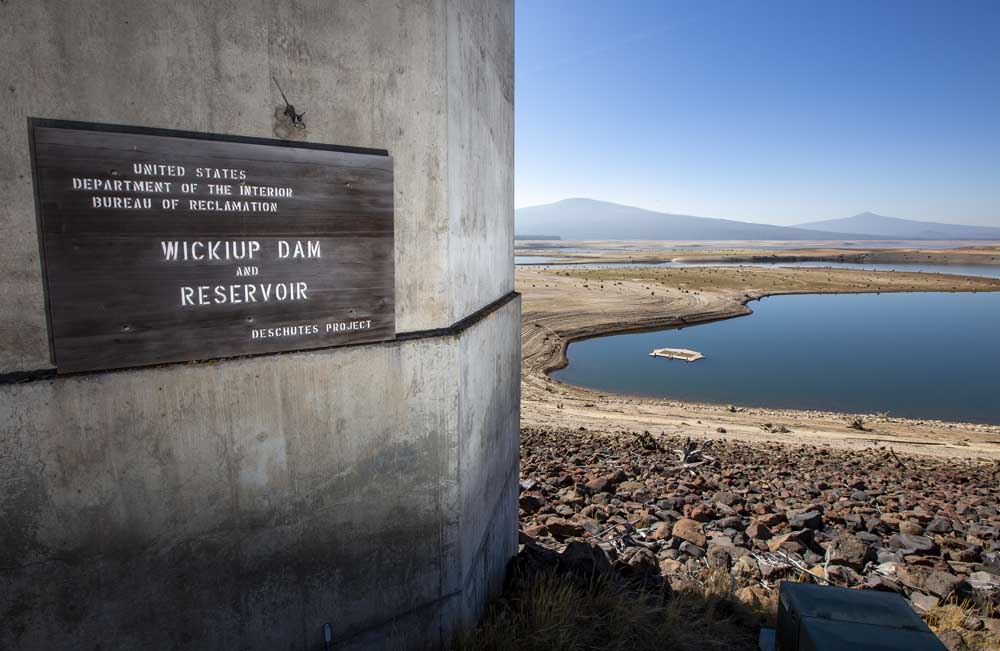Guest column: Water sources for farmers are less reliable
Published 9:00 pm Tuesday, November 19, 2024

- Low water levels expose stumps and sand near the dam at Wickiup Reservoir in October 2022.
Water, water, every where, Nor any drop to drink” is a line from Coleridge’s 1834 epic poem, the Rime of the Ancient Mariner. Our region’s farmers might sympathize with that seaman as they are finding their water source becoming less reliable.
When the U. S. Fish and Wildlife Service listed the Oregon spotted frog as threatened and created a habitat plan for its protection, it diverted reservoir storage to winter in-stream flows benefiting the frog. The North Unit Irrigation District, which in the past had access to about 120,000 AF (acre feet) of water stored at Wickiup reservoir, will soon have access to only about 46,000 AF because of the gradually increasing river flow requirements.
The Deschutes Basin Board of Control, which administers the habitat plan, proposes recovering irrigation canal seepage by piping 132 miles of canal costing $441 million. A recent 7.9 mile $33 million piping project was expected to save 31 cfs (cubic feet per second); it saved just 21 cfs. If the North Unit’s 25 mile delivery canal was piped and saved 21 cfs every 7.9 miles, the amount of seepage water recovered in a six-month irrigation season would be 24,000 AF. Combining this with the reduced reservoir storage would give the North Unit 70,000 AF but still 50,000 AF short of its typical water requirements. Additional water for the North Unit could come from piping projects in other districts, but that is not a sure thing when farm economics are considered.
The U.S. Department of Agriculture has surveyed Oregon county agriculture businesses six times since 1987 to determine their net annual income. In 1987 and 1992, Jefferson, Crook and Deschutes counties each had positive farm incomes. In the four more recent surveys, done at intervals from 2002 to 2022, Jefferson County had net positive incomes and Crook County had three positive incomes but reported a loss in 2022. However, Deschutes County reported losses in those four surveys ranging between $12 and $24 million and averaging $17.9 million (adjusted to 2024 dollars). These losses were in the four surveys, but if the average loss is typical over those 21 years, as is likely, piping Deschutes County canals is an economic non-starter.
A study published in 1994 evaluated the frog’s historical presence in the Willamette Valley and the Klamath Basin. It was estimated that 74% habitat loss in those areas was due to extensive agricultural development early in the twentieth century. A 1997 study raised the habitat loss to 79% and possibly 90% if all effects were considered. These studies presented no population data, but did trigger a flurry of agency documents: two biological appraisals and two biological opinions (843 pages), an environmental impact statement (1043 pages), the habitat plan (843 pages) plus multiple technical and environmental documents. Five field studies covering26 years resulted in an extensive data set stored as xml and csv files and apparently produced one technical article about obscure risk statistics. One would expect that buried somewhere in all those pages and files there would be a definitive statement that the Deschutes Basin frog population is trending down and listing was necessary. But there is none.
A few months ago, it appeared that the habitat plan’s water delivery restrictions would cause the North Unit to scale back activities with some farms ceasing operation. But that may change with the Supreme Court’s rejection of the Chevron deference, making agencies less autonomous and their regulations more easily challenged.
Farmers now have a chance of success when challenging the habitat rules that restrict their water supply. They could ask congress to reform the Endangered Species Act; Congressman Bentz has held hearings on the ESA and is sympathetic. Senators Wyden and Merkley’s stance is characterized by their recent reauthorization of funds, $17 million through 2033, for the Deschutes River Conservancy to continue their “Raise the Deschutes” activities. Or the farmers could file a lawsuit. We shall see.
Editor’s Note
Do you have a point you’d like to make or an issue you feel strongly about? Submit a letter to the editor or a guest column.








